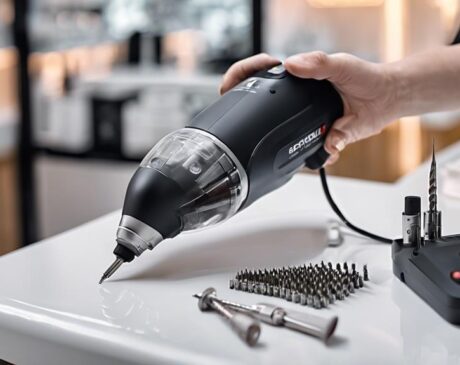What Is the Best Bonding Glue for Wood?
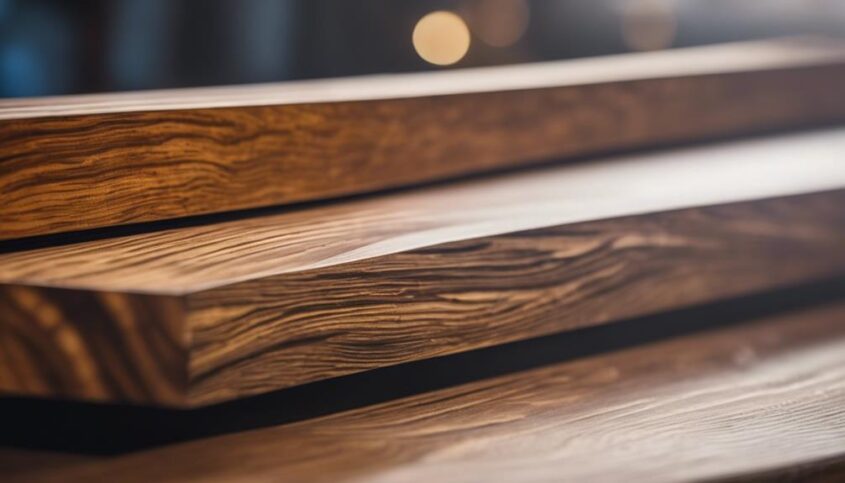
When bonding wood, the best glue depends on the type of wood you are using. For general woodworking projects, consider PVA glue for its strong bond and quick drying. If you need water-resistant properties, polyurethane glue is a great choice. Cyanoacrylate glue offers quick bonding with minimal clamping. For high durability and heat resistance, epoxy resin is ideal. Remember, different glues suit different needs, so choose wisely for the best results. There are various options available to cater to your specific woodworking requirements.
Key Takeaways
- Consider wood type for proper adhesive match.
- PVA glue: strong, quick-drying, versatile, and durable.
- Polyurethane glue: strong, water-resistant, and versatile.
- Cyanoacrylate glue: quick, precise, and strong bonds.
- Epoxy resin: water-resistant, clear finish, and durable bonds.
Types of Wood Bonding Glue
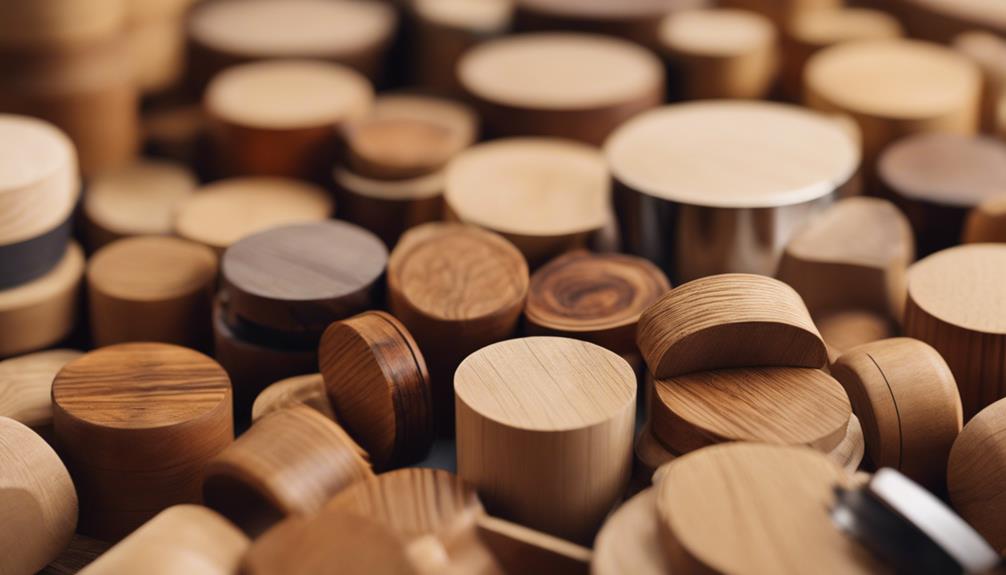
When choosing wood bonding glue, consider the type of wood you're working with as it can impact the adhesive's effectiveness. Different woods have varying levels of porosity and hardness, which can affect how well the glue bonds. For hardwoods like oak or maple, a strong adhesive such as polyurethane glue might be more suitable due to its ability to create a durable bond. On the other hand, softwoods like pine or cedar may work well with aliphatic resin glue, which penetrates the wood fibers effectively.
It's crucial to match the properties of the wood with the right type of adhesive to ensure a secure bond that can withstand the test of time. By understanding the characteristics of the wood you're using, you can make an informed decision on the best wood bonding glue for your project. Remember, the key to a successful wood bonding project lies in choosing the right glue that complements the specific traits of the wood you're working with.
PVA Glue
When working with wood, PVA glue is a go-to choice for many due to its strong adhesion capabilities and quick drying time.
It bonds wood surfaces effectively, creating sturdy connections that can withstand various pressures and strains.
Using PVA glue can help you achieve reliable and durable woodwork projects.
Strong Wood Adhesion
For strong wood adhesion, consider using a high-quality PVA glue for optimal bond strength. PVA (Polyvinyl Acetate) glue is commonly known as wood glue and is preferred for its strong bond and easy cleanup. Here's a quick breakdown of the benefits of using PVA glue for wood projects:
| Benefits of PVA Glue for Wood | ||
|---|---|---|
| Strong Bond | Easy to Clean | Versatile |
| Non-Toxic | Dries Clear |
PVA glue is ideal for woodworking projects where a strong, reliable bond is essential. Its versatility and non-toxic nature make it a popular choice among DIY enthusiasts and professional woodworkers alike.
Quick Drying Time
To achieve a quick drying time with PVA glue, ensure proper application and minimal excess for optimal results. When working with PVA glue, follow these tips for a faster drying process:
- Apply a thin, even layer of glue to the wood surface.
- Avoid using too much glue, as excess glue can prolong drying time.
- Use clamps or weights to hold the pieces together tightly while the glue dries.
- Allow for proper ventilation in the drying area to speed up the process.
- Consider using a hairdryer on a low, cool setting to help accelerate the drying of the PVA glue.
Polyurethane Glue
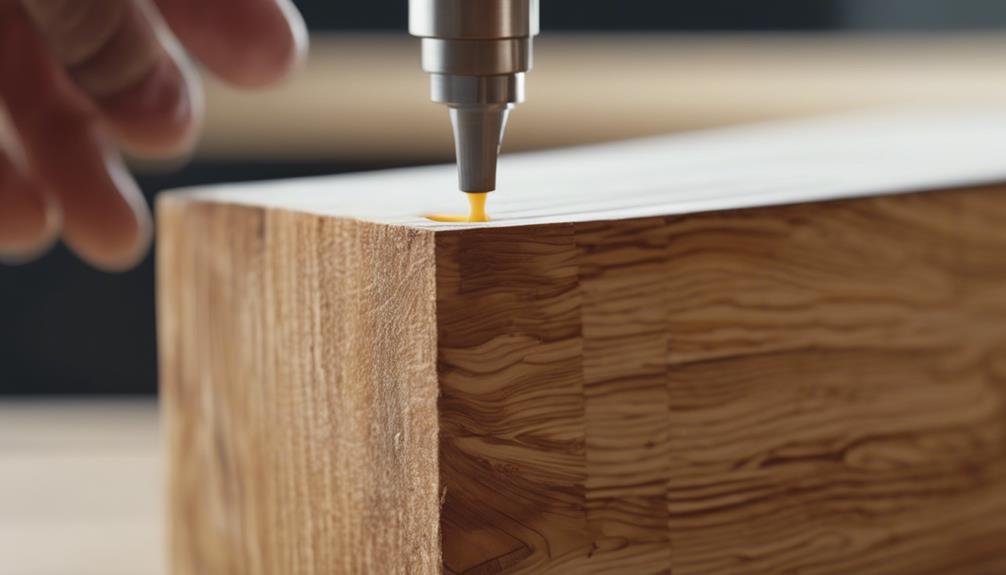
Consider using polyurethane glue for a strong and durable bond when working with wood. This type of glue is known for its versatility and excellent adhesive properties. Unlike traditional wood glues, polyurethane glue doesn't require a perfect fit between surfaces to create a strong bond. It actually works best when there are small gaps or uneven surfaces to be joined.
One of the key benefits of polyurethane glue is its resistance to water, making it ideal for both indoor and outdoor woodworking projects. This glue expands as it dries, filling in gaps and creating a bond that isn't only strong but also waterproof.
Another advantage of polyurethane glue is its ability to bond different types of materials besides wood, such as metal, plastic, and even stone. This flexibility can be a game-changer for projects that involve multiple materials.
Cyanoacrylate Glue
When selecting bonding glue for wood, cyanoacrylate glue offers a fast and reliable option for creating strong connections. This type of glue, commonly known as super glue, can be a great choice for various woodworking projects. Here are some reasons why cyanoacrylate glue might be the right option for you:
- Quick Bonding: Cyanoacrylate glue sets rapidly, allowing you to work efficiently without long waiting times.
- Versatile: This glue works well with different types of wood, making it a versatile choice for various woodworking applications.
- Precision: Its liquid form enables precise application, ensuring that the glue goes exactly where you need it.
- Minimal Clamping: In many cases, cyanoacrylate glue doesn't require clamping, saving you time and effort during assembly.
- Strength: Despite its fast setting time, cyanoacrylate glue creates strong bonds that can withstand everyday wear and tear.
Epoxy Resin
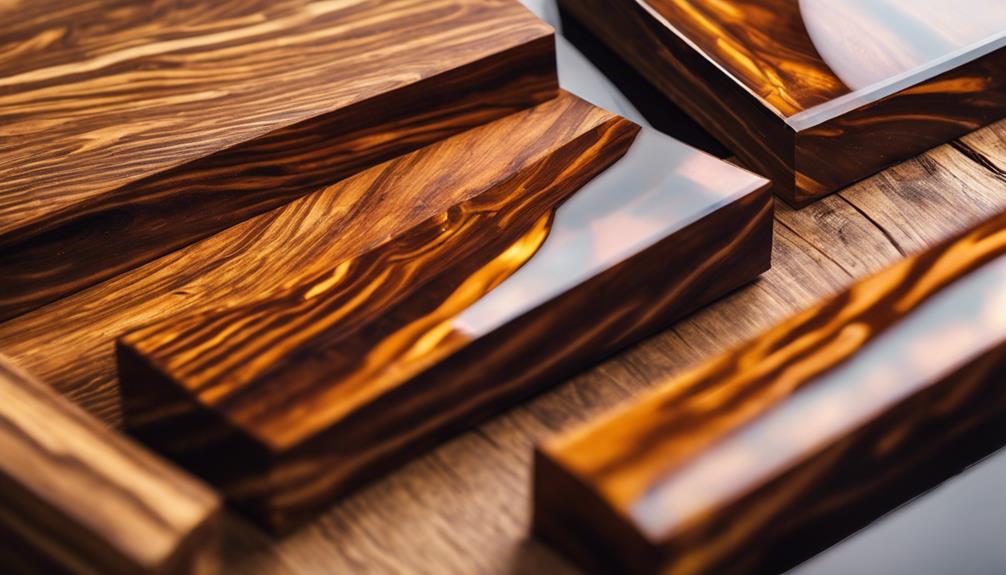
Wondering how epoxy resin can enhance your woodworking projects? Epoxy resin is a versatile adhesive that offers you the freedom to create strong and durable bonds in your wood projects. Unlike other glues, epoxy resin doesn't require perfect fits between surfaces to create a solid bond. It fills gaps and can be used on uneven surfaces, giving you more flexibility in your woodworking.
One of the great benefits of epoxy resin is its water-resistant properties, making it ideal for outdoor projects or items that may be exposed to moisture. It also provides excellent heat resistance, ensuring that your projects remain intact even in high-temperature environments. Additionally, epoxy resin dries to a clear finish, blending seamlessly with your wood for a professional look.
When using epoxy resin, make sure to follow the instructions carefully for the best results. By incorporating epoxy resin into your woodworking arsenal, you can achieve strong, long-lasting bonds that withstand various conditions, giving you the freedom to create with confidence.
Hide Glue
For a traditional woodworking adhesive with a strong bond, consider using hide glue. Hide glue has been used for centuries and is still favored by many woodworkers for its reliability and ease of use. Here are some reasons why hide glue might be the right choice for your woodworking projects:
- Strong Bond: Hide glue creates a bond that's incredibly strong, making it ideal for joining wood pieces securely.
- Reversible: One of the advantages of hide glue is that it's reversible, allowing for easier repairs or disassembly if needed.
- Natural Ingredients: Hide glue is made from natural ingredients, which may appeal to those seeking more environmentally friendly options.
- Easy to Clean: Any excess hide glue can be easily cleaned up with water while it's still wet, simplifying the woodworking process.
- Versatile: Hide glue can be used for a variety of woodworking applications, from furniture making to instrument building, showcasing its versatility in different projects.
Wood Glue Sticks
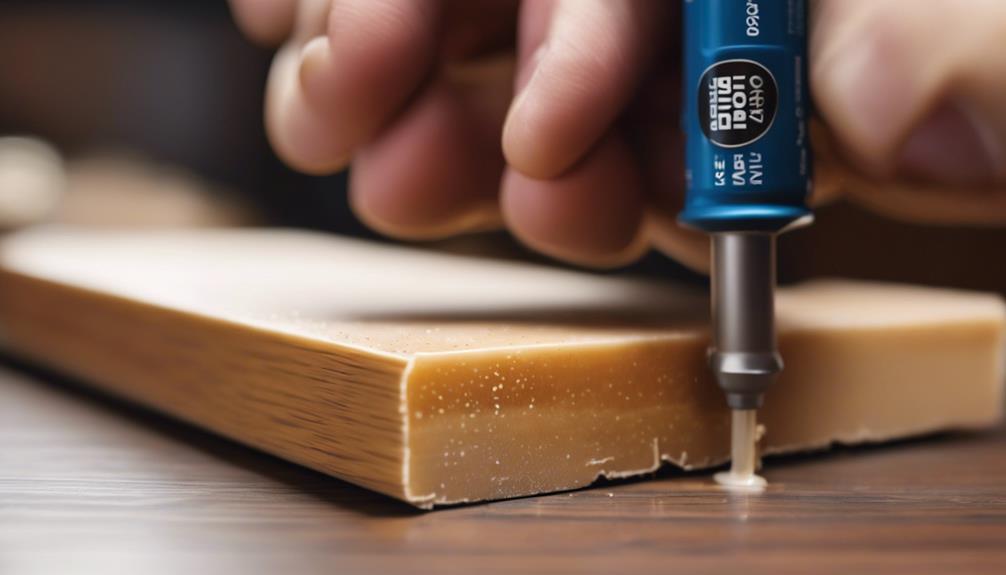
Wood glue sticks offer strong adhesion for your wood projects, ensuring a reliable bond. They also boast a quick drying time, allowing you to move forward with your work swiftly.
These features make wood glue sticks a convenient and efficient choice for your woodworking needs.
Strong Wood Adhesion
To achieve strong wood adhesion, consider using wood glue sticks for a reliable bond. Wood glue sticks offer a convenient and effective way to ensure your woodworking projects stay intact. Here are some reasons why they're a great choice:
- No mess, no fuss application
- Versatile for different types of wood
- Provides a durable and long-lasting bond
- Easy to handle and apply precisely where needed
- Ideal for quick fixes and small projects
With wood glue sticks, you have the freedom to work confidently, knowing that your wood pieces will be securely bonded together.
Quick Drying Time
Achieving rapid adhesion, wood glue sticks with quick drying properties offer efficiency in bonding wood pieces seamlessly. When time is of the essence, these glue sticks provide the freedom to work swiftly without compromising the quality of the bond.
No more waiting around for hours for the glue to set – with quick-drying wood glue sticks, you can move on to the next steps of your project almost immediately. Whether you're a professional woodworker or a casual DIY enthusiast, having a reliable adhesive that dries fast can make all the difference in your workflow.
Embrace the convenience and speed that quick-drying wood glue sticks bring to your woodworking projects, saving you time and helping you achieve professional results efficiently.
Contact Cement
For a strong and lasting bond on your woodworking projects, consider using contact cement. Contact cement is a versatile adhesive that offers a reliable way to bond wood pieces together. Here are some reasons why contact cement might be the right choice for your next project:
- Instant Bonding: Contact cement creates an instant bond when the two surfaces coated with the adhesive are pressed together.
- No Clamping Required: Unlike other glues, contact cement doesn't need clamping to set. This gives you the freedom to work without the need for constant pressure on the bond.
- Waterproof: Contact cement is resistant to water and moisture, making it ideal for projects that may be exposed to environmental elements.
- Flexible Bond: It provides a flexible bond that can withstand movement and changes in temperature without compromising its strength.
- Great for Large Surfaces: Contact cement is perfect for bonding large surface areas quickly and efficiently.
Polyvinyl Acetate Glue
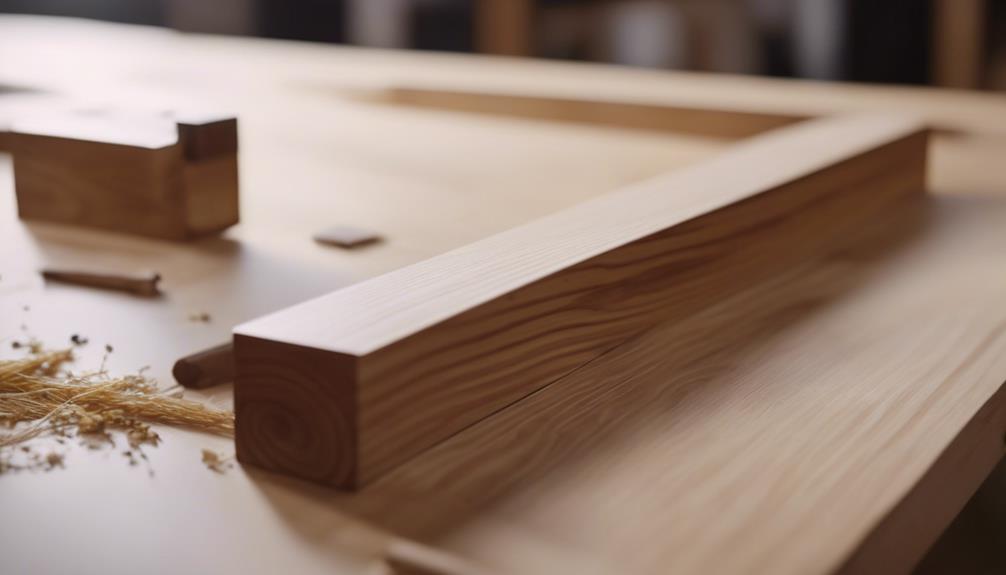
Consider using Polyvinyl Acetate Glue for wood projects as it offers a reliable and strong bonding solution. Also known as PVA glue, this type of adhesive is versatile and easy to work with. It's commonly used in woodworking due to its ability to create a strong bond between different types of wood.
One of the advantages of Polyvinyl Acetate Glue is its ease of use. It dries quickly, allowing you to proceed with your project without long waiting times. Additionally, it's water-based, making it easy to clean up any excess glue with just water while it's still wet.
Whether you're working on a DIY project or a professional woodworking task, Polyvinyl Acetate Glue can provide the bond strength you need. It's suitable for a wide range of wood types and can be used for both indoor and outdoor applications. Next time you embark on a woodworking project, consider reaching for Polyvinyl Acetate Glue for a reliable and durable bond.
Urea-formaldehyde Glue
When looking for a strong bonding solution for wood projects, Urea-formaldehyde Glue stands out as a reliable option due to its durable properties. This type of glue provides a solid bond that can withstand the test of time, making it a popular choice among woodworkers.
Here are some key points to consider about Urea-formaldehyde Glue:
- Excellent Adhesion: Urea-formaldehyde Glue creates strong bonds between wood surfaces, ensuring your projects stay intact.
- Water Resistance: This glue offers resistance to water, making it suitable for both indoor and outdoor woodworking projects.
- Heat Resistance: It can withstand moderate heat levels, adding to its durability and reliability.
- Long Shelf Life: Urea-formaldehyde Glue has a long shelf life when stored properly, allowing you to use it for multiple projects over time.
- Versatile Application: You can use this glue for various wood types and joinery applications, providing flexibility in your woodworking endeavors.
Frequently Asked Questions
Can Bonding Glue Be Used on All Types of Wood, or Are There Certain Types of Wood That Are Not Compatible With Certain Types of Glue?
When using bonding glue on wood, consider compatibility. Not all wood types work with every glue. Some woods may not bond well with certain adhesives. Test a small area first to ensure a strong bond.
How Long Does Bonding Glue Typically Take to Dry Before It Reaches Its Maximum Bonding Strength?
When bonding wood, your glue needs time to fully set. It usually takes a bit to reach its peak strength. Be patient and let it do its thing. Rushing it won't give you the strong bond you want.
Are There Any Safety Precautions or Ventilation Requirements When Using Bonding Glue Indoors?
When using bonding glue indoors, ensure proper ventilation to prevent inhaling fumes. Additionally, wear gloves to protect your skin and work in a well-lit area. Safety first! Follow these precautions for a successful bonding experience.
Can Bonding Glue Be Used for Outdoor Woodworking Projects, or Is It Only Suitable for Indoor Use?
For outdoor woodworking projects, bonding glue can be suitable if it's specified for both indoor and outdoor use. Check the product label for this information, ensuring your wood creations stay strong in various conditions without compromising quality.
Are There Any Specific Tips or Techniques for Removing Excess Bonding Glue or Cleaning up Spills and Messes?
When cleaning up spills or removing excess bonding glue, remember: like a fresh start, patience and care are key. Wipe gently with a damp cloth for wet glue or carefully scrape for dried glue.

